
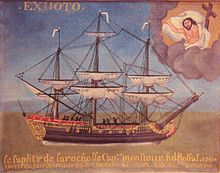
An ex-voto is a votive offering to a saint or a divinity, given in fulfillment of a vow (hence the Latin term, short for ex voto suscepto, "from the vow made") or in gratitude or devotion. [1] The term is usually restricted to Christian examples.


An ex-voto is a votive offering to a saint or a divinity, given in fulfillment of a vow (hence the Latin term, short for ex voto suscepto, "from the vow made") or in gratitude or devotion. [1] The term is usually restricted to Christian examples.
Ex-votos are placed in a church or chapel where the worshiper seeks grace or wishes to give thanks. The destinations of pilgrimages often include shrines decorated with ex-votos.
Ex-votos can take a wide variety of forms. They are not only intended for the invocated, but also as a testimony to later visitors of the received help. As such they may include texts explaining a miracle attributed to the helper, or symbols such as a painted or modeled reproduction of a miraculously healed body part, or a directly related item such as a crutch given by a person formerly lame. There are places where a very old tradition of depositing ex-votos existed, such as Abydos in ancient Egypt. [2]
Especially in the Latin world, there is a tradition of votive paintings, typically depicting a dangerous incident which the offeror survived. The votive paintings of Mexico are paralleled in other countries. In Italy, where more than 15,000 ex-voto paintings are thought to survive from before 1600, these began to appear in the 1490s, probably modelled on the small predella panels below altarpieces. [3] These are a form of folk art, in Mexico typically painted cheaply on tin plates salvaged from packaging.
Other examples may be large and grand paintings, such as Titian's Jacopo Pesaro being presented by Pope Alexander VI to Saint Peter , given in thanks for a naval victory. In Venice it became the custom in the Renaissance for the higher officials, beginning with the Doge, to commission (at their personal expense) an ex-voto painting in the form of a portrait of themselves with religious figures, usually the Virgin or saints, in thanks for achieving their office. For lower officials only their coat of arms might represent the official. The painting was hung in the public building where they worked or presided. [4] An example is the Barbarigo Altarpiece, a votive portrait of Doge Agostino Barbarigo with the Virgin and Child, two saints and assorted angels, by Giovanni Bellini (1488). This was made for the Doge's Palace but is now in San Pietro Martire, Murano.
The Ex-Voto de 1662 is a painting by Philippe de Champaigne (now Louvre), showing two nuns, one of whom recovered from serious illness.
In the church of Notre-Dame de la Garde in Marseille, France, the site of a major local pilgrimage, the ex-votos include paintings, plaques, model ships, war medals and even football shirts given by players and supporters of Olympique de Marseille, the local team. The magnificent Lod mosaic is thought to be an ex-voto expressing gratitude for rescue from a shipwreck. [5] In the long Votive Chapel of Saint Joseph's Oratory in Montreal, there are fixed on iron grilles hundreds of crutches, canes and braces left behind by pilgrims who claimed to have received a healing while meeting with Brother André, CSC. Pope Benedict XVI recognized the authenticity of the miracles and canonized Saint André Bessette in 2011. [6]

Tiziano Vecelli or Vecellio ,, Latinized as Titianus, hence known in English as Titian, was an Italian (Venetian) Renaissance painter of Lombard origin, considered the most important member of the 16th-century Venetian school. He was born in Pieve di Cadore, near Belluno. During his lifetime he was often called da Cadore, 'from Cadore', taken from his native region.

Giovanni Bellini was an Italian Renaissance painter, probably the best known of the Bellini family of Venetian painters. He was raised in the household of Jacopo Bellini, formerly thought to have been his father, but now that familial generational relationship is questioned. An older brother, Gentile Bellini was more highly regarded than Giovanni during his lifetime, but the reverse is true today. His brother-in-law was Andrea Mantegna.
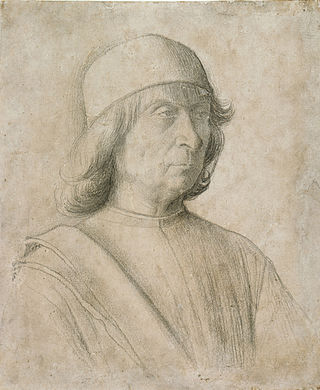
Gentile Bellini was an Italian painter of the school of Venice. He came from Venice's leading family of painters, and at least in the early part of his career was more highly regarded than his younger brother Giovanni Bellini, the reverse of the case today. From 1474 he was the official portrait artist for the Doges of Venice, and as well as his portraits he painted a number of very large subjects with multitudes of figures, especially for the Scuole Grandi of Venice, wealthy confraternities that were very important in Venetian patrician social life.

The Basilica di Santa Maria Gloriosa dei Frari, commonly abbreviated to the Frari, is a church located in the Campo dei Frari at the heart of the San Polo district of Venice, Italy. It is the largest church in the city and it has the status of a minor basilica. The church is dedicated to the Assumption of Mary.

The Basilica dei Santi Giovanni e Paolo, known in Venetian as San Zanipolo, is a church in the Castello sestiere of Venice, Italy.

A retablo is a devotional painting, especially a small popular or folk art one using iconography derived from traditional Catholic church art. More generally retablo is also the Spanish term for a retable or reredos above an altar, whether a large altarpiece painting or an elaborate wooden structure with sculptures. Typically this includes painting, sculpture or a combination of the two, and an elaborate framework enclosing it. The Latin etymology of the Spanish word means "board behind". Aside from being found behind the altar, "similar ornamental structures are built and carved over facades and doorways", called overdoors.

The Pietà is one of the last paintings by the Italian master Titian, and in its final, extended state was left incomplete at his death in 1576, to be completed by Palma Giovane. Titian had intended it to hang over his grave, and the two stages of painting were to make it fit in two different churches. It is now in the Gallerie dell'Accademia in Venice.

The Pesaro Madonna is a painting by the late Italian Renaissance master Titian, commissioned by Jacopo Pesaro, whose family acquired in 1518 the chapel in the Frari Basilica in Venice for which the work was painted, and where it remains today. Jacopo was Bishop of Paphos, in Cyprus, and had been named commander of the papal fleet by the Borgia pope, Alexander VI. This painting recalls one of Titian's earliest paintings Jacopo Pesaro being presented by Pope Alexander VI to Saint Peter, c. 1510-11

Italian Renaissance painting is the painting of the period beginning in the late 13th century and flourishing from the early 15th to late 16th centuries, occurring in the Italian Peninsula, which was at that time divided into many political states, some independent but others controlled by external powers. The painters of Renaissance Italy, although often attached to particular courts and with loyalties to particular towns, nonetheless wandered the length and breadth of Italy, often occupying a diplomatic status and disseminating artistic and philosophical ideas.

The Madonna dell'Orto is a church in Venice, Italy, in the sestiere of Cannaregio. This was the home parish of Tintoretto and holds a number of his works as well as his tomb.

Domenico Robusti, also known as Domenico Tintoretto, was an Italian painter from Venice. He grew up under the tutelage of his father, the renowned painter Jacopo Tintoretto.

Venetian painting was a major force in Italian Renaissance painting and beyond. Beginning with the work of Giovanni Bellini and his brother Gentile Bellini and their workshops, the major artists of the Venetian school included Giorgione, Titian, Tintoretto (1518–1594), Paolo Veronese (1528–1588) and Jacopo Bassano (1510–1592) and his sons. Considered to give primacy to colour over line, the tradition of the Venetian school contrasted with the Mannerism prevalent in the rest of Italy. The Venetian style exerted great influence upon the subsequent development of Western painting.
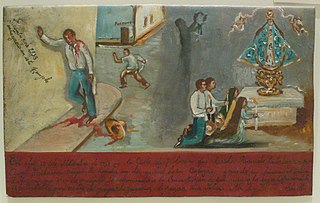
Votive paintings in Mexico go by several names in Spanish such as “ex voto,” “retablo” or “lámina,” which refer to their purpose, place often found, or material from which they are traditionally made respectively. The painting of religious images to give thanks for a miracle or favour received in this country is part of a long tradition of such in the world. The offering of such items has more immediate precedence in both the Mesoamerican and European lines of Mexican culture, but the form that most votive paintings take from the colonial period to the present was brought to Mexico by the Spanish. As in Europe, votive paintings began as static images of saints or other religious figures which were then donated to a church. Later, narrative images, telling the personal story of a miracle or favor received appeared. These paintings were first produced by the wealthy and often on canvas; however, as sheets of tin became affordable, lower classes began to have these painted on this medium. The narrative version on metal sheets is now the traditional and representative form of votive paintings, although modern works can be executed on paper or any other medium.

The church of Santa Maria Assunta, known as I Gesuiti, is a religious building in Venice, Italy. It is located in the sestiere of Cannaregio, in Campo dei Gesuiti, not far from the Fondamenta Nuove.
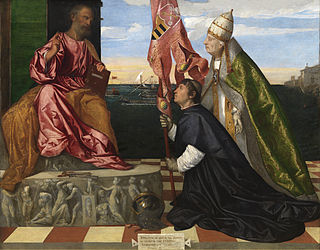
Jacopo Pesaro being presented by Pope Alexander VI to Saint Peter is an oil painting on canvas by Titian, now in the Royal Museum of Fine Arts in Antwerp.

San Lio is a church located on the campo of the same name in the sestiere of Castello.
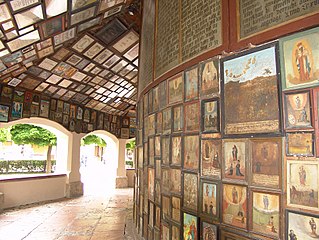
A votive offering or votive deposit is one or more objects displayed or deposited, without the intention of recovery or use, in a sacred place for religious purposes. Such items are a feature of modern and ancient societies and are generally made in order to gain favor with supernatural forces.

The Barbarigo Altarpiece or Enthroned Madonna and Child with Angel Musicians and Saint Mark, Saint Augustine and Doge Agostino Barbarigo is a 1488 oil painting on panel by Giovanni Bellini, now in the church of San Pietro Martire in Murano.

The Judgement of Solomon is an oil on canvas painting by Sebastiano del Piombo of the Judgement of Solomon, executed c. 1505–1510, now in the Bankes collection at Kingston Lacy, a National Trust property in Dorset, England.